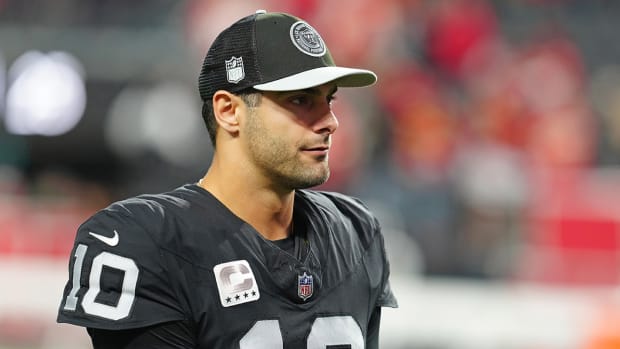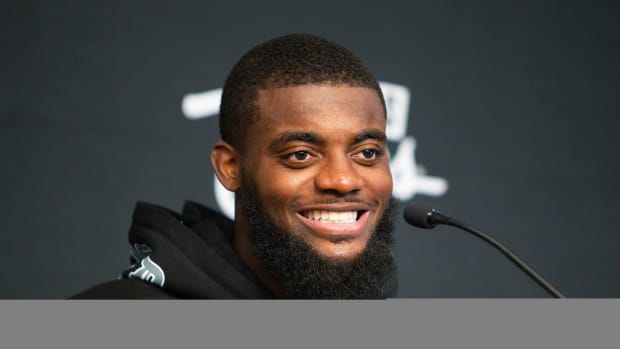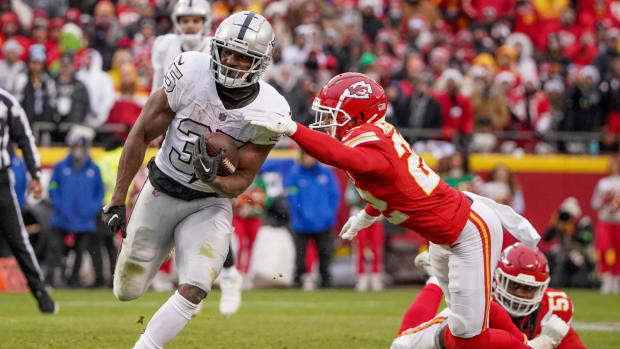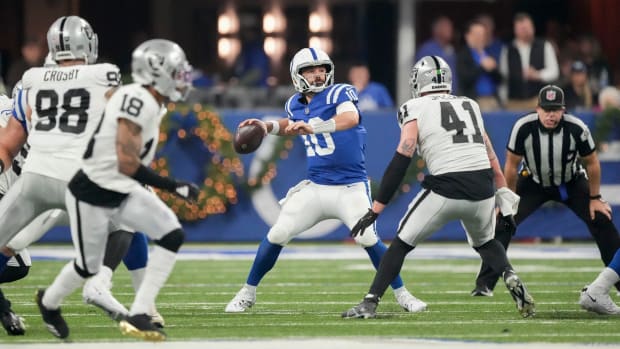Raiders All-Time Top Five: Fullbacks
1. Mark van Eeghen, 1974-1981
The Raiders, with their prolific passing game, also were a power running team during the 1970s, led by two fullbacks from Colgate—Marv Hubbard and Mark van Eeghen. Hubbard came first and he tutored Van Eeghen when he came to the Silver and Black as a third-round pick (No. 75 overall) in the 1974 NFL Draft. Van Eeghen became the full-time starter in 1976 and helped the Raiders reach the Super Bowl by rushing for 1,112 yards on 233 carries and scoring three touchdowns in addition to catching 17 passes for 133 yards. Even though the Raiders were a fullback-oriented rushing team, Van Eeghen gladly became the lead blocker and terrorized the Minnesota Vikings linebackers as Clarence Davis rushed for 137 yards, and Pete Banaszak ran for two short-yardage touchdowns as the Silver and Black trounced the Minnesota Vikings, 32-14, in Super Bowl XI. And Van Eeghen rushed for 73 yards himself. “Van Eeghen’s blocking was a key to us dominating that game the way we did,” quarterback Kenny Stabler said. The 6-3, 233-pound Van Eeghen was the Raiders all-time leading rusher when he retired, and still is second behind Marcus Allen, with 5,907 yards on 1,475 carries and 35 touchdowns, in addition to catching 174 passes for 1,583 yards and four touchdowns. When the Raiders defeated the Philadelphia Eagles in Super Bowl XV, 27-10, four years later, Van Eeghen got his chance to lead the way on the ground with 75 yards on 18 carries. While Van Eeghen left the Raiders in 1982 to spend his last two seasons near home with the New England Patriots, he says, “I’m a Raider, through and through.” He finished his NFL career with 6,651 yards rushing 1,652 carries and 37 ran for touchdowns. Van Eeghen also caught 174 passes for 1,583 yards and four TDs.
2. Marv Hubbard, 1969-1975
Hubbard led the Raiders in rushing from 1971-74, but when Mark van Eeghen joined the Raiders in 1974, to his credit he took the fellow Colgate star under his wing even though he knew his protégé would eventually take his starting job. The Hubbard 6-1, 230-pound Hubbard was selected by the Raiders in the 11th round (No. 277 overall) of the 1968 American Football League Draft, but was released and signed with the Denver Broncos, who also released him. Instead, he signed with the Hartford Knights of the Atlantic Coast Football League, which he helped to a 15-1 record and led the team to the league title while finishing with more than 1,000 yards to lead the league in rushing. Hubbard re-signed with the Raiders in 1969 but didn’t really get going until two years later, when he rushed for 867 yards on 181 carried and scored five touchdowns, following that with his best season, gaining 1,100 yards on 219 carries, and scoring four times. He finished his career in Oakland with 913 carries for 4,394 yards and 22 touchdowns and played in the Pro Bowl from 1971-73. Hubbard missed the 1977 season because of a shoulder injury, but played his last season with the Detroit Lions and gained 150 yards on 38 carries, and scored once. Hubbard averaged 4.82 yards per carry during his professional career, third all-time for an NFL fullback behind Hall of Fame fullbacks Jim Brown and Joe Perry, and is tied for 13th all-time in yards per carry for any player in NFL history. That’s better than the likes of Walter Payton, O.J. Simpson, Eric Dickerson, Emmitt Smith, and Marshall Falk. Hubbard relished playing against the arch-rival Kansas City Chiefs and their All-Pro middle linebacker Willie Lanier, and their one-on-one battles were classic. “The hole opened and their he was, Willie Lanier,” Hubbard said after one game in which he led the Raiders to victory. “I put my head down and hit him right between the numbers, and knocked him on his back.” Hubbard died on May 4, 2015, three days shy of his 69th birthday, from complications of prostate cancer.
3. Pete Banaszak, 1966-1978
The 5-11, 210-pound Banaszak played both halfback and fullback for the Raiders but did some of his most memorable work late in his career when he played mostly fullback and became one of the best short-yardage runners in NFL history. The highlight of his career was scoring touchdowns from one and two yards out as the Raiders trounced the Minnesota Vikings, 32-14, in Super Bowl XI to cap the 1976 season, and it didn’t matter that he rushed for only 19 yards on 10 carries backing up Clarence Davis and Mark van Eeghen, who combined for 210 yards rushing. When the Raiders needed short-yardage for a first down or a touchdown, they gave the ball to Banaszak and he rarely disappointed. “We knew that when we gave the ball to Pete, he would get the first down or the touchdown, somehow, some way,” quarterback Kenny Stabler said. “He was the best short-yardage runner I ever saw.” Banaszak, known as “The Rooster,” was selected in the fifth round (No. 59 overall) of the 1966 American Football League Draft out of Miami in Florida and played his entire 13-year NFL career in Silver and Black. He rushed 964 times for 3,772 bruising yards and 47 touchdowns, and he also caught 121 passes for 1,022 yards and five scores. In 19 playoff games, Banaszak had 427 yards on 115 carries and scored five times. His best season was 1975 when he totaled 672 yards on 187 carries and led the NFL with 16 touchdowns. Banaszak started in place of injured Clem Daniels in Super Bowl II and gained 16 yards on six carries, while catching four passes for 69 yards, including a 41-yarder. In addition, he was the middle man in the famed “Holy Roller,” when Stabler intentionally fumbled forward while being sacked and Banaszak scooped the ball toward the goal line, where tight end Dave Casper recovered for a touchdown to beat the San Diego Chargers, 21-20, in 1978. Banaszak lives in St. Augustine, Fla., and co-hosts a post-game radio show for the Jacksonville Jaguars.
4. Tyrone Wheatley, 1999-2004
When Wheatley played in the Raiders' backfield alongside Napoleon Kaufman in 1999 and 2000, he essentially was the fullback because he was 6 feet and 230 pounds, compared to 5-9 and 185 pounds for his running mate. Wheatley was selected in the first round (No. 17 overall) of the 1995 National Football League Draft by the New York Giants out of Michigan. He rushed for more than 1,100 yards in each of his last three seasons with the Wolverines and finished with 668 carries for 4,187 yards and 47 touchdowns, in addition to catching 51 passes for 510 yards and six scores. Wheatley capped his college career by being named Big Ten Offensive Player of the Year and Most Valuable Player of the 79th Rose Bowl after rushing for 235 yards on 15 carries, 15.7 yards per carry, and touchdowns of 88, 56, and 24 yards in a 38-31 victory over Washington. After four seasons with the Giants, during which he rushed for 1,280 yards on yards on 356 carries and scored eight touchdowns, he came to the Raiders in 1999 and really came into his own. Wheatley rushed for 936 yards on 242 carries and eight touchdowns in his first season in Oakland, which equaled his four-year scoring output in New York. He also caught 21 passes for 196 yards and three TDs. He followed with his best season as a pro in 2000, rushing for 1,046 yards on 232 carries, a 4.5-yard average, and nine touchdowns, including an 80-yard scoring run. He added 20 receptions for 156 yards and another score. Wheatley finished his six seasons in Oakland with 3,682 yards, eighth-best in Raiders history, on 914 carries, and scored 32 touchdowns. He also caught 92 passes for 682 yards and five touchdowns. Wheatley’s career ended after he sustained an acute torn hamstring injury in a game against the Denver Broncos in 2004. For his 10-year NFL career, he rushed for 4,962 yards on 1,270 yards and 40 touchdowns, in addition to catching 125 passes for 900 yards and seven scores. After retirement, Wheatley went into coaching in 2007 and now is the head coach at Morgan State.
5. Hewritt Dixon, 1966-70
The 6-2, 230-pound Hewritt Dixon gave the Raiders a formidable backfield in 1966 and 1967 alongside Clem Daniels, and when Daniels was lost to a knee injury in that second season, Dixon became the Silver and Black’s long-distance threat out of the backfield. In the 1967 American Football League Championship Game, Dixon ran 69 yards for the first touchdown of the game and finished with 144 yards on 21 carries in a 40-7 trouncing of the Houston Oilers. He also led the Raiders with 54 yards on 12 carries as they lost, 33-14, to the Green Bay Packers in Super Bowl II. Dixon was drafted by the Denver Broncos in the eighth round (No. 60 overall) in the 1966 American Football League Draft, and also was selected by the Pittsburgh Steelers in the 11th round (No. 151 overall) of the NFL Draft, but signed with the Broncos. He played in only five games as a rookie and had three unproductive seasons in Denver before signing with the Raiders in 1966 when his career took off, and he was selected to the AFL All-Star Game from 1966 to 1968 and was a first-team All-AFL selection in 1970. Dixon rushed for 2,960 yards on 731 carries and scored 13 touchdowns in his five years in Oakland, in addition to catching 190 passes for 1,750 yards and 10 touchdowns. Very fast for his size, he scored on pass plays of 76, 62, 59, 48, 46, 41, and 37 yards in his career. His best season came in 1968 when Daniels did not return because of his injury, and Dixon rushed for 865 yards on 206 carries, with two touchdowns, and caught 38 passes for 360 yards and two more scores. After rushing for 861 yards and a touchdown on 197 carries, and catching 31 passes for 207 yards and another score in 1970, Dixon surprisingly retired at the age of 30. But not before he scored the first touchdown for the Silver and Black in their initial appearance on Monday Night Football, sweeping left behind a block from guard Gene Upshaw and running 39 yards for a score on the Raiders’ first offensive play of the game. Dixon rushed for 164 yards in 18 carries in a 34-20 over the Washington Redskins in the game. After he retired following that season, Dixon settled in Los Angeles and spent many years aiding youth offenders at Eastlake Juvenile Hall before dying of cancer far too young at the age of 52 in 1992.
Please make sure you tell us your thoughts when you like our Facebook Page WHEN YOU CLICK RIGHT HERE.
Want the latest breaking Las Vegas Raiders news delivered straight to you? CLICK THE FOLLOW button on the top of the page. Don't miss any of the latest up to the second updates for your Las Vegas Raiders when you follow on Twitter @HondoCarpenter, @HikaruKud1




